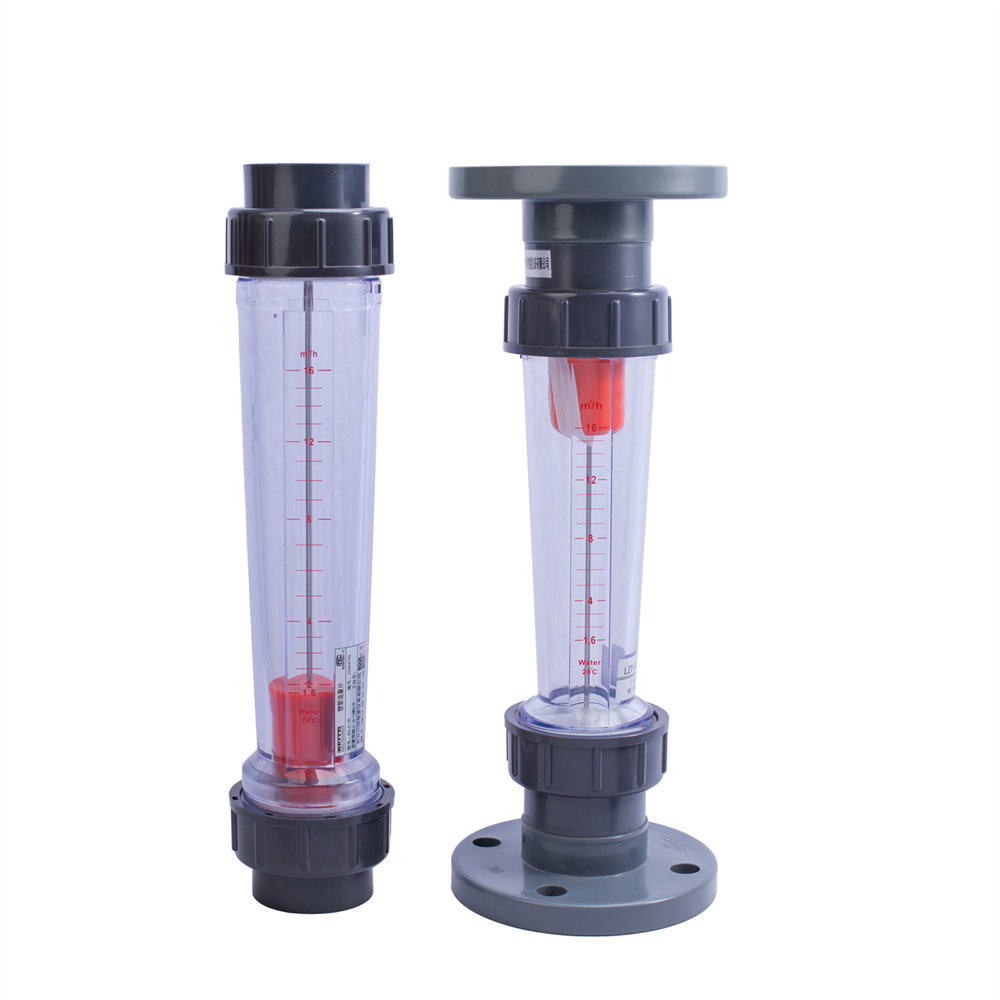Введение продукта
1. Flowmeter structure: mainly consists of a transparent plastic cone tube with the small end facing downward and the large end facing upward, and a float that can move up and down in the cone tube, as well as a nut, a pipe, a guide rod, a stopper, etc.
2. Appearance as shown: mainly divided into short tube type and long tube type. According to the connection method, it is divided into plug-in connection, threaded connection and flange connection.
Parts name and materials
|
Serial number |
Имя |
Material |
|
1 |
Pipe |
ABS |
|
2 |
Nut |
ABS |
|
3 |
“O-ring” |
Nitrile rubber |
|
4 |
Lower stopper |
ABS |
|
5 |
Float |
ABS lining |
|
6 |
Cone tube |
PS |
|
7 |
Upper stopper |
ABS |
|
8 |
Guide rod |
316 |
Note: 1. Conventional joints are ABS engineering plastics countersunk connections, and can also be connected with PVC countersunk or ABS internal threads;
2. Under special circumstances, the guide rod can be made of F46 lined with 304 stainless steel;
3. "O" rings can also be made of fluororubber, etc. |
Specifications and Models
|
Модель |
Measuring Range |
Medium |
Remarks |
LZT-15S
(Long Tube) |
6-60L/h |
Water |
Without guide rod |
|
| 10-100L/h |
|
16-160L/h |
|
25-250L/h |
|
40-400L/h |
|
60-600L/h |
LZT-25S
(Long tube) |
60-600L/h |
|
|
100-1000L/h |
|
160-1600L/h |
|
250-2500L/h |
|
300-3000L/h |
LZT-40S
(Long tube) |
0.4-4m3/h |
|
|
0.6-6m3/h |
LZT-50S
(Long tube) |
0.4-4m3/h |
|
|
0.6-6m3/h |
|
1-10m3/h |
|
1.6-16m3/h |
With guide rod |
|
LZT-100S
LZT-125S
LZT-150S |
8-50m3/h |
Flange connection with guide rod |
|
|
|
|
12-60m3/h |
|
14-90m3/h |
|
18-120m3/h |
|
18-150m3/h |
|
22-180m3/h |
|
25-200m3/h |
|
Модель |
Диапазон измерений |
Medium |
Remarks |
LZT-15S
(Short tube) |
6-60L/h |
Water |
With guide rod |
|
|
|
10-100L/h |
|
16-160L/h |
|
25-250L/h |
|
40-400L/h |
|
60-600L/h |
|
100-1000L/h |
LZT-25S
(Short tube) |
100-1000L/h |
|
|
160-1600L/h |
|
250-2500L/h |
|
300-3000L/h |
LZT-32S
(Short tube) |
0.4-4m3/h |
|
|
0.6-6m3/h |
LZT-50S
(Short tube) |
1-10m3/h |
|
|
1.6-16m3/h |
LZT-65S
(Short tube) |
5-25m3/h |
|
|
8-40m3/h |
|
12-60m3/h |
|
LZT-80S |
5-25m3/h |
Flange connection with guide rod |
|
|
|
|
8-40m3/h |
|
12-60m3/h |
Note: 1. The above is the normal flow rate, and special flow rate is also available.
2. The flow meter has an accuracy level of 4, with a pressure resistance of ≤0.6Mpa, and the medium used is water or diluted acid or alkali with a concentration of less than 30%, and the temperature is generally 0℃~40℃, and can be used up to 65℃ for a short time. |
Precautions
(1) Before installation, the outlet pipe of the flowmeter should be disassembled and the foam or plastic pipe support inside the meter should be removed, and then the pipe should be reinstalled. Note that the "O" ring should be installed in the groove of the pipe when reinstalling.
(2) The interface of the flowmeter can be connected with a matching plastic pipe (ABS or PVC) by gluing with special glue. It can also be connected to the plastic flange first and then to the metal flange.
(3) The flowmeter must be installed vertically (the angle between the center of the flowmeter and the plumb line does not exceed 5°). The installation height should be convenient for the float reading, and the line of sight should be level with the float reading position when reading.
(4) The straight pipe section of the upstream and downstream inlet and outlet of the flowmeter should be ≥5 times the nominal diameter of the meter.
(5) If the measured fluid contains large particles of impurities or dirt, a filter should be installed upstream of the flowmeter.
(6) If the measured liquid is a pulsating flow, which causes the float fluctuation to be unable to measure normally, a buffer and a setter of appropriate size should be set upstream of the flowmeter.
(7) Try to use the appropriate flow range of the flow meter to test the flow rate (the appropriate flow range generally refers to 40% to 70% of the upper limit flow rate).

